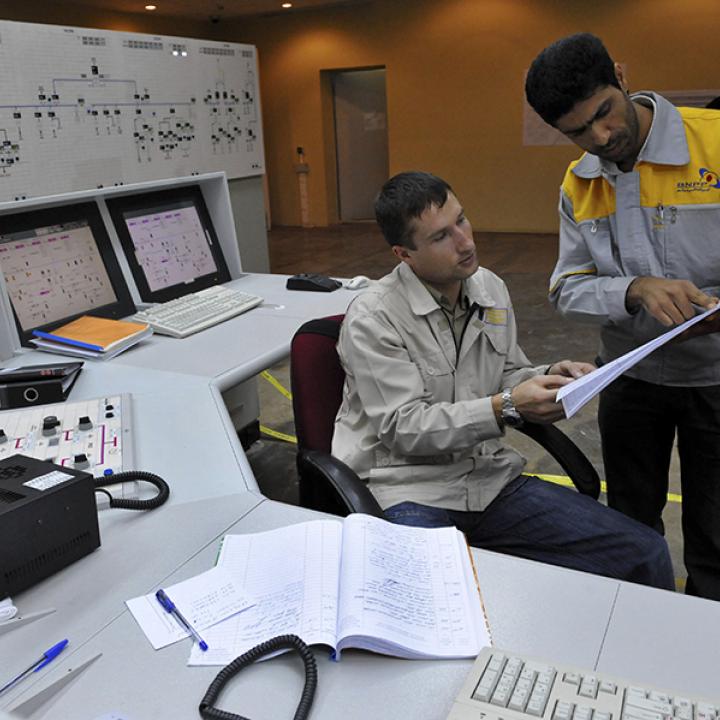
- Policy Analysis
- Articles & Op-Eds
Iran's Plan to Expand Its Nuclear Program -- and Steps the U.S. Can Take to Deter It

In response to a recently publicized document describing Iran's nuclear intentions, the next U.S. administration should first make clear that being aware of Iran's plans is not the same as acquiescing to them.
Rarely in foreign policy does one get a decade's advance notice of a crisis. But that's effectively what happened last month when the Associated Press reported on a previously unpublicized document describing how Iran plans to expand its nuclear program beginning in January 2027: by installing thousands of centrifuges capable of enriching uranium faster than its current models.
It's well known that the Iran nuclear agreement is a temporary accommodation; Iran will be free of its restrictions beginning in less than a decade. The question is what can be done now to prepare for that eventuality.
The agreement that six world powers and Iran reached last July is careful to describe limitations on Tehran's nuclear activities for the coming decade as voluntary steps consistent with Iran's own plans; not framing things as restrictions imposed by outside powers presumably helped the Iranian regime save face. The catch is that Iran's "enrichment and enrichment R&D plan" not only describes what Iran is to refrain from doing in the first 10 years of the agreement but also how it expects to expand its nuclear program thereafter.
Whether or not they had seen the document, Obama administration officials seemed familiar with Iran's intentions -- and the implications. President Barack Obama told NPR in April 2015, after the framework for the nuclear agreement was reached, that "in year 13, 14, 15, [Iran has] advanced centrifuges that enrich uranium fairly rapidly, and at that point the breakout times would have shrunk almost down to zero."
The problem of the nuclear deal's "sunset," phased in after the 10th year of the agreement, is widely acknowledged by analysts and other experts who otherwise disagree on the agreement's merits. Even President Obama said last year that the deal amounted to "purchasing for 13, 14, 15 years assurances that the breakout is at least a year...at the end of that period, maybe they've changed, maybe they haven't." In other words, the can has been kicked down the road.
The expansion of Iran's nuclear program could profoundly destabilize the Middle East. There is widespread suspicion in the region about Iran's intentions. Iran's rivals are likely to seek to develop their own deterrents -- nuclear or otherwise -- especially if they believe that the U.S. does not take the matter seriously.
President Obama has suggested that a future U.S. president may have superior options, should Iran choose to resume its march toward nuclear weapons. His successor would "have much more insight into [Iran's] capabilities," presumably as a result of inspections under the nuclear deal.
There are, of course, risks to a wait-and-see approach. Nuclear inspectors would be hard-pressed to account for Iran's nuclear activities if they rapidly expand, and possession of advanced centrifuges may aid Iranian efforts to conceal its work. Any renewed sanctions would depend on political leadership in the U.S. and Europe -- a factor that is uncertain -- and may face stiff resistance from businesses that have returned to Iran. And Iran may well use the time to better develop its conventional military capabilities to deter attack, enabled by the relaxation of sanctions on its arms and missiles.
In the face of all this, other steps can be taken now to deter Iran from expanding its nuclear program as the 2015 agreement sunsets. First, the next U.S. administration can make clear that being aware of Iran's plans is not the same as acquiescing to them, and that we reserve the right to oppose Iran's nuclear expansion. The U.S. should reassert its opposition to Iran developing nuclear weapons capability and to the general spread of nuclear weapons technology. This policy would gain credibility by the U.S. actively deterring and responding to Iranian provocations in the region as well as any violations of the nuclear agreement. Such a policy should not preclude the use of sanctions or force should Iran seek a nuclear weapon, nor should it rule out the negotiation of a follow-on accord that exchanges further incentives for further nuclear restrictions.
In parallel, the U.S. can also lead an effort to restrict the spread of enrichment and reprocessing technology generally. This would provide a firm policy foundation to rally international opposition to the expansion of Iran's nuclear capabilities. Such an approach could involve making the global nonproliferation regime -- which currently permits non-nuclear states to engage in almost any nuclear activity short of weapons production if they produce a feasible civilian purpose -- more restrictive, as has been suggested by George Perkovich of the Carnegie Endowment for International Peace. It could also involve making nuclear fuel-cycle activities multilateral -- for example, by creating nuclear "fuel banks" that would obviate the need for states to pursue their own enrichment capabilities.
Any successful policy likely requires the U.S. to pursue all of these steps, not to choose from among them. Doing nothing to head off this crisis in the making only ensures that it will be bigger, and worse, when it arrives.
Michael Singh is the Lane-Swig Senior Fellow and managing director at The Washington Institute. This article originally appeared on the Wall Street Journal blog "Think Tank."
Wall Street Journal



